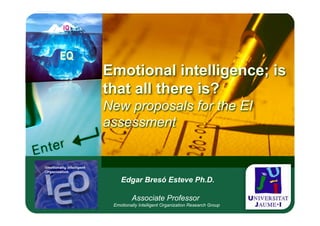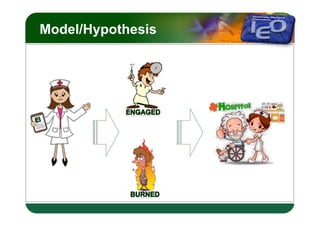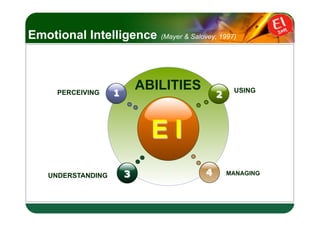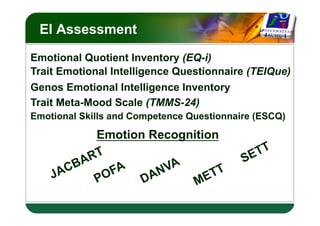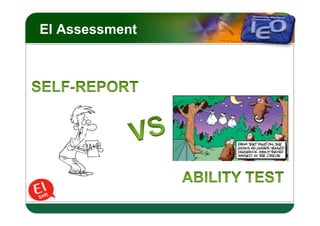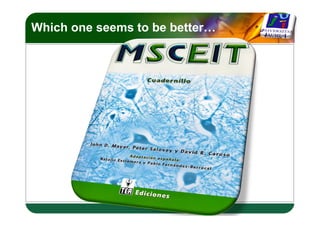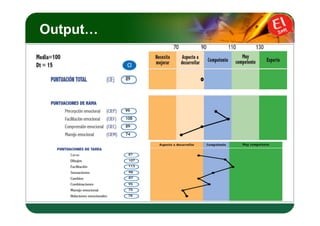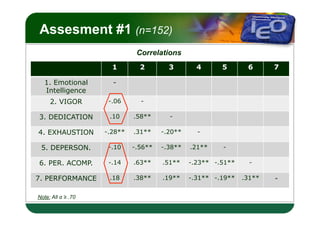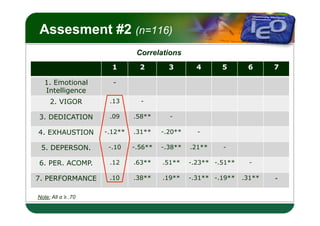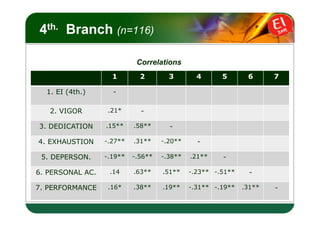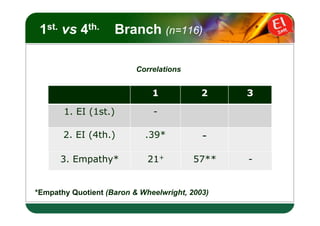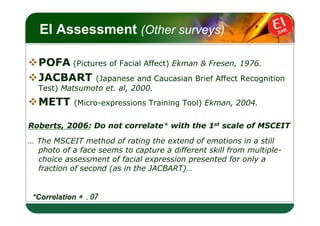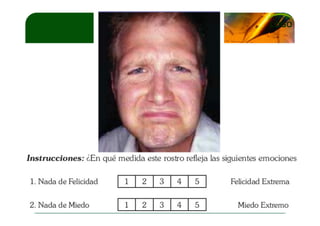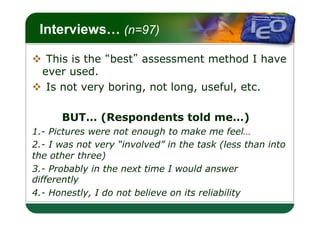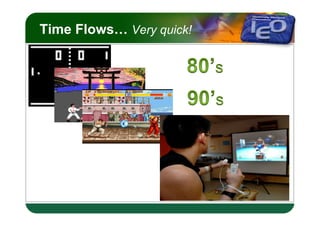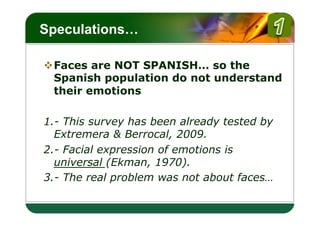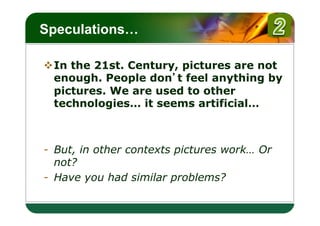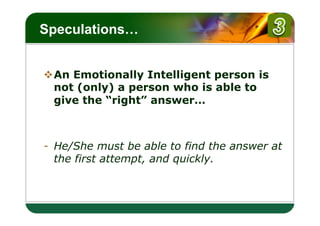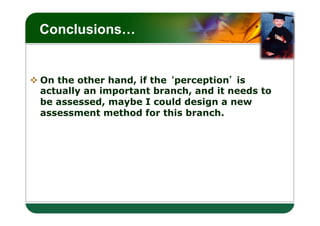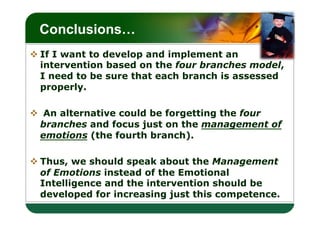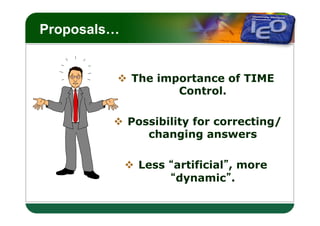Ei assessment
- 1. Emotional intelligence; is that all there is? New proposals for the EI assessment Edgar Bres├│ Esteve Ph.D. Associate Professor Emotionally Intelligent Organization Research Group
- 3. LOGO Emotional Intelligence (Mayer & Salovey, 1997) 1 ABILITIES USING PERCEIVING 2 EI UNDERSTANDING 3 4 MANAGING
- 4. LOGO EI Assessment Emotional Quotient Inventory (EQ-i) Trait Emotional Intelligence Questionnaire (TEIQue) Genos Emotional Intelligence Inventory Trait Meta-Mood Scale (TMMS-24) Emotional Skills and Competence Questionnaire (ESCQ) Emotion Recognition
- 6. LOGO Which one seems to be betterŌĆ”
- 8. LOGO Assesment #1 (n=152) Correlations 1 2 3 4 5 6 7 1. Emotional - Intelligence 2. VIGOR -.06 - 3. DEDICATION .10 .58** - 4. EXHAUSTION -.28** .31** -.20** - 5. DEPERSON. -.10 -.56** -.38** .21** - 6. PER. ACOMP. -.14 .63** .51** -.23** -.51** - 7. PERFORMANCE .18 .38** .19** -.31** -.19** .31** - Note: All ╬▒ Ōēź .70
- 9. LOGO Assesment #2 (n=116) Correlations 1 2 3 4 5 6 7 1. Emotional - Intelligence 2. VIGOR .13 - 3. DEDICATION .09 .58** - 4. EXHAUSTION -.12** .31** -.20** - 5. DEPERSON. -.10 -.56** -.38** .21** - 6. PER. ACOMP. .12 .63** .51** -.23** -.51** - 7. PERFORMANCE .10 .38** .19** -.31** -.19** .31** - Note: All ╬▒ Ōēź .70
- 10. LOGO 4th. Branch (n=116) Correlations 1 2 3 4 5 6 7 1. EI (4th.) - 2. VIGOR .21* - 3. DEDICATION .15** .58** - 4. EXHAUSTION -.27** .31** -.20** - 5. DEPERSON. -.19** -.56** -.38** .21** - 6. PERSONAL AC. .14 .63** .51** -.23** -.51** - 7. PERFORMANCE .16* .38** .19** -.31** -.19** .31** -
- 11. LOGO 1st. vs 4th. Branch (n=116) Correlations 1 2 3 1. EI (1st.) - 2. EI (4th.) .39* - 3. Empathy* 21+ 57** - *Empathy Quotient (Baron & Wheelwright, 2003)
- 12. LOGO EI Assessment (Other surveys) v’üČŌĆ»POFA (Pictures of Facial Affect) Ekman & Fresen, 1976. v’üČŌĆ»JACBART (Japanese and Caucasian Brief Affect Recognition Test) Matsumoto et. al, 2000. v’üČŌĆ»METT (Micro-expressions Training Tool) Ekman, 2004. Roberts, 2006: Do not correlate* with the 1st scale of MSCEIT ŌĆ” The MSCEIT method of rating the extend of emotions in a still photo of a face seems to capture a different skill from multiple- choice assessment of facial expression presented for only a fraction of second (as in the JACBART)ŌĆ” *Correlation Ōēģ
- 13. LOGO
- 14. LOGO InterviewsŌĆ” (n=97) v’üČŌĆ» This is the best assessment method I have ever used. v’üČŌĆ» Is not very boring, not long, useful, etc. BUTŌĆ” (Respondents told meŌĆ”) 1.- Pictures were not enough to make me feelŌĆ” 2.- I was not very ŌĆ£involvedŌĆØ in the task (less than into the other three) 3.- Probably in the next time I would answer differently 4.- Honestly, I do not believe on its reliability
- 15. LOGO Time FlowsŌĆ” Very quick!
- 16. LOGO SpeculationsŌĆ” v’üČŌĆ»Faces are NOT SPANISHŌĆ” so the Spanish population do not understand their emotions 1.- This survey has been already tested by Extremera & Berrocal, 2009. 2.- Facial expression of emotions is universal (Ekman, 1970). 3.- The real problem was not about facesŌĆ”
- 17. LOGO SpeculationsŌĆ” v’üČŌĆ»In the 21st. Century, pictures are not enough. People don t feel anything by pictures. We are used to other technologiesŌĆ” it seems artificialŌĆ” -ŌĆ» But, in other contexts pictures workŌĆ” Or not? -ŌĆ» Have you had similar problems?
- 18. LOGO SpeculationsŌĆ” v’üČŌĆ»An Emotionally Intelligent person is not (only) a person who is able to give the ŌĆ£rightŌĆØ answerŌĆ” -ŌĆ» He/She must be able to find the answer at the first attempt, and quickly.
- 19. LOGO ConclusionsŌĆ” v’üČŌĆ»On the other hand, if the perception is actually an important branch, and it needs to be assessed, maybe I could design a new assessment method for this branch.
- 20. LOGO ConclusionsŌĆ” v’üČŌĆ»If I want to develop and implement an intervention based on the four branches model, I need to be sure that each branch is assessed properly. v’üČŌĆ» An alternative could be forgetting the four branches and focus just on the management of emotions (the fourth branch). v’üČŌĆ»Thus, we should speak about the Management of Emotions instead of the Emotional Intelligence and the intervention should be developed for increasing just this competence.
- 21. LOGO ProposalsŌĆ” v’üČŌĆ» The importance of TIME Control. v’üČŌĆ» Possibility for correcting/ changing answers v’üČŌĆ» Less artificial , more dynamic .

